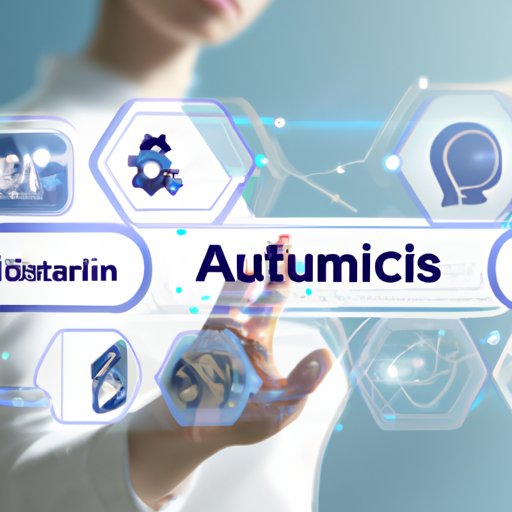Introduction
Artificial intelligence (AI) is rapidly transforming the world as we know it. As technology advances, the potential for AI to shape the future is becoming increasingly evident. From automation of manufacturing and industrial processes to enhanced human-computer interaction and improved cybersecurity, AI is revolutionizing the way we live and work. In this article, we will explore how AI is already changing the world and what potential opportunities it may bring in the future.
Automation of Manufacturing and Industrial Processes
One of the most significant ways that AI is transforming the future is through automation of manufacturing and industrial processes. Automation has the potential to increase efficiency, reduce costs, improve product quality, and reduce the risk of human error. According to a survey conducted by the International Federation of Robotics, “The use of robots has enabled manufacturers to increase productivity, reduce costs and create jobs.”
Examples of automated processes in manufacturing and industrial fields include robotic assembly lines, automated material handling systems, and intelligent monitoring systems. These technologies can be used to streamline production processes, reduce waste, and increase production capacity. Additionally, they can also be used to help ensure compliance with safety standards and regulations.
Enhancing Human-Computer Interaction
Another way that AI is transforming the future is through enhanced human-computer interaction. AI-driven technologies are enabling computers to interact with humans in more natural and intuitive ways. This can be beneficial in a variety of areas, including customer service, marketing, and product design. For example, AI-enabled chatbots can be used to provide more personalized customer service experiences and AI-powered voice assistants can be used to improve user experience.
Examples of current technologies that are enhancing human-computer interaction include virtual reality, augmented reality, natural language processing, and facial recognition. These technologies can be used to create immersive experiences, enable faster and more accurate communication, and provide better insights into customer behavior.
Healthcare Revolution
AI is also revolutionizing the healthcare industry. AI-powered technologies have the potential to improve patient care, reduce medical errors, and reduce healthcare costs. For example, AI-powered diagnostic tools can be used to quickly and accurately diagnose patients, while AI-driven predictive analytics can be used to anticipate potential health issues and take preventative measures.
Examples of how AI is being used to revolutionize the healthcare industry include machine learning algorithms that can be used to detect diseases such as cancer, AI-assisted robotic surgery, and AI-powered chatbots that can provide personalized health advice. These technologies have the potential to drastically improve patient outcomes and reduce the burden on healthcare providers.
Autonomous Vehicles
AI is also playing an important role in the development of autonomous vehicles. Autonomous vehicles have the potential to reduce traffic congestion, improve safety, and reduce fuel consumption. For example, autonomous vehicles can be programmed to follow traffic laws and avoid collisions, allowing for safer and more efficient travel.
Examples of current autonomous vehicle technologies include self-driving cars, driverless delivery vehicles, and automated aerial drones. These technologies are already being used in a variety of industries, from logistics to agriculture, and are expected to become increasingly widespread in the near future.
Increased Personalization
AI is also enabling increased personalization in a variety of areas. Personalization can be beneficial in a variety of contexts, from marketing to product design. For example, AI-driven recommendation engines can be used to provide users with personalized product recommendations, while AI-powered chatbots can be used to provide more tailored customer service experiences.
Examples of current personalized technologies include AI-powered virtual assistants, personalized search results, and AI-driven product recommendations. These technologies are making it easier than ever before for businesses to provide personalized experiences to their customers.
Improved Cybersecurity
AI is also being used to improve cybersecurity. AI-driven technologies can be used to detect and respond to cyber threats in real time, making it easier for organizations to protect themselves from malicious attacks. For example, AI-powered security systems can be used to detect suspicious activity and alert security personnel to potential threats.
Examples of current technologies that are improving cybersecurity include AI-powered malware detection systems, AI-driven intrusion detection systems, and AI-enabled fraud detection systems. These technologies can be used to detect and respond to cyber threats quickly and accurately, helping organizations stay one step ahead of malicious actors.
Education and Training Opportunities
Finally, AI is also creating new opportunities for education and training. AI-driven technologies can be used to create personalized learning experiences, track student progress, and provide feedback in real time. For example, AI-powered tutoring systems can be used to provide students with tailored instruction and guidance, while AI-enabled virtual classrooms can be used to provide interactive learning experiences.
Examples of current AI-driven education and training platforms include AI-powered online courses, AI-enabled educational games, and AI-driven virtual tutors. These technologies are helping to make education more accessible and providing new opportunities for students to learn and grow.
Conclusion
In conclusion, AI is transforming the future in a variety of ways. From automation of manufacturing and industrial processes to enhanced human-computer interaction and improved cybersecurity, AI is revolutionizing the way we live and work. Additionally, AI has the potential to revolutionize healthcare, create autonomous vehicles, increase personalization, and create new opportunities for education and training. As technology continues to evolve, AI will continue to shape the future in exciting and unexpected ways. We invite readers to explore the potential of AI and its implications for the future.
(Note: Is this article not meeting your expectations? Do you have knowledge or insights to share? Unlock new opportunities and expand your reach by joining our authors team. Click Registration to join us and share your expertise with our readers.)
